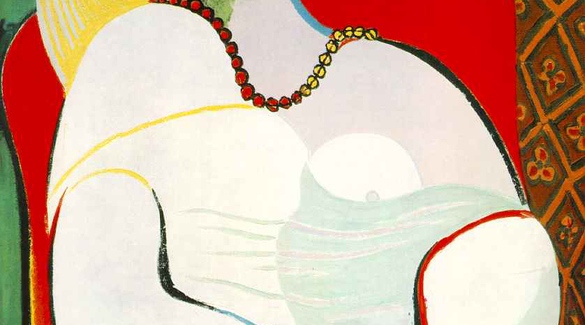NAC Articles

Le Reve, by Pablo Picasso, first sold for $7,000 and later for $139 million
Repeat Sales Values
Sales Trends, the Artist's Resale Right, and the Saskatchewan Art Market
by NAC contributor Jess Boyachek
The Artist’s Resale Right guarantees artists a share in the profits of their art as their works are resold. A closer look at how art increases in value reveals that ARR can mean significant benefit for Saskatchewan artists.
To understand how resale value trends may play out in Saskatchewan, it is first important to consider that Canada's art market is somewhat apart from that of the rest of the world – the majority Canadian art is sold, and re-sold, within Canada. Unique national trends and interests, including a general preference among Canadian collectors for landscapes, make the Canadian market distinct. And a recent study, “Dynamic Price Dependence of Canadian and International Markets; An Empirical Analysis” (Hodgson and Seçkin, 2011) determined that price trends in the international market do not tend to match those in the Canadian market, particularly in the long term. That said, some factors that influence art value increases are universal.
Works increase in value for a number of reasons, some of them seemingly mysterious. An increase in the artist’s reputation or prominence is perhaps the most obvious factor, and it seems logical that works from an artist's best-known period are most likely to gain value. But other influences are harder to pinpoint and may not be immediately obvious. For example, the provenance of a work may be important – if a prominent person has owned the work, or it has been displayed in a famous location, the work's value is likely to increase. Any public exhibition of an artwork solidifies its provenance, and illustration in an exhibition catalogue or other publications similarly helps to establish an artwork’s reputation as a significant example of an artist’s work.
Excitement around a work that has been “off the market” for a long time may also contribute to its increased value. A 2011 report in The Telegraph relayed the story of Kate Ganz, whose parents had possessed a large collection of important works: “Right after my mother died [in 1997] – she died second – we were inundated by teams of people from Sotheby’s and Christie’s descending on the house,” Ganz recalls. “That was fairly uncomfortable, but that’s their job.”
Ganz's father had bought Picasso's 1932 painting Le Rêve for $7,000 in 1941; Ganz and her siblings sold it in November 1997 for $48.4 million. In 2006, the painting was to be sold again, this time by casino magnate Steve Wynn, for $139 million: but while enthusiastically telling friends about the impending sale Wynn accidentally put his elbow through the canvas, causing a six-inch tear and forfeiting the deal.
Trends in art come and go, but artworks from some periods and styles generate higher rates of return for investors. Skate's Art Market Research has found that since 1985, postmodernist works have generally received the highest rate of return, while works created during the rise and golden age of Impressionism tended to have the highest value (average purchase price $4,154,645 USD).
Stories of tremendous increases in art value abound; Skate's has tracked many dramatic increases in its “Top 1000” most valuable works. Isamu Noguchi's 1926 work “Undine (Nadja)” was purchased for $155,350 in 2007; in 2010, it sold for $3,700,000. Auguste Rodin's “Le Penseur, Taille de la Porte dit Moyen modele” (created 1880) more than doubled in value in less than one year, being purchased for $4,051,278 and then sold for $10,500,000 in 2010. Andy Warhol's “One Dollar” (1961) was purchased for $489,750 in 2000; seven years later, it sold for $3,600,000.
Of course, Saskatchewan art prices are more modest than those described above, but they also often show increases in value. Regina Five artist Ted Godwin's painting “Lost Creek” was sold at Hodgins Art Auctions (Calgary) for $1000 in 2001; the work was sold at the same auction house in 2008 for $1700. Several of Ivan Eyre's prints have increased significantly in value (although it should be noted that the value of prints also depends on the unique condition of each print). Eyre's “Black Rider” sold for $160 at Hodgins in 1995; it sold for $375 at Levis Fine Art Auctions (Calgary) in 2002. His work “Cover” sold for $75 at Levis in 2010; the same auction house sold the same print for $150 the following year.
Frequently, price increases occur within short periods of time. “Tall Trees,” a 1971 oil painting by Saskatchewan’s Dorothy Knowles, sold for $2250 at Heffel Fine Art (Vancouver) in 2010. The following year, the same auction house sold the painting for $2750 – a $500 increase. In an even larger leap, Bruno Bobak's oil painting “Soft Summer Evening” sold through Ritchie's Auctioneers (Toronto) for $1700 in 2003 and the next year at the same auction house for $2500.
For collectors of Saskatchewan art, these kinds of price increases are encouraging, and for the artists, certainly gratifying. But if the Artist’s Resale Right becomes law in Canada, increased resale values for artworks will bring profits as well as pride to the artists who created them.
Jess Boyachek is a Regina-based writer and researcher. Her writing has appeared in University of Regina publications, in Splice magazine, and on the web. In 2011, she was a participant in the Saskatchewan Writers' Guild's Mentorship Program.
Featured Articles
Connect With Us

